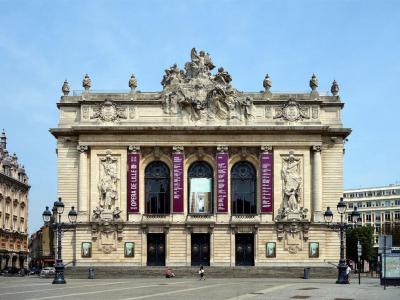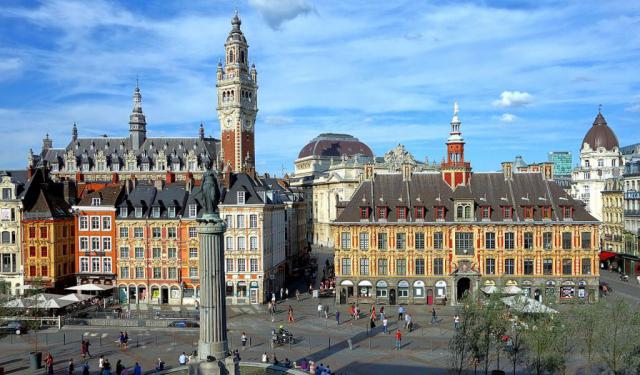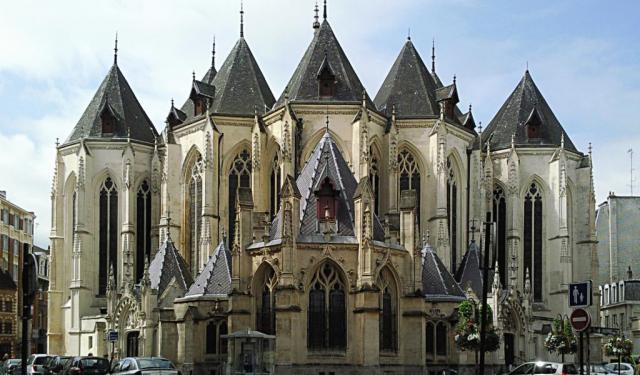Opéra de Lille (Lille Opera), Lille
The Lille Opera (Opéra de Lille) is an example of Neoclassical architecture, seamlessly integrated with the adjacent Chamber of Commerce and Old Stock Exchange. The current structure was erected from 1907 to 1913 after its predecessor, dating back to 1785, was destroyed by fire in 1903.
The design of the new opera house was the vision of architect Louis Marie Cordonnier, selected through a competitive process. His Belle Époque style is evident in the building's grand façade, which features an elaborate pediment relief crafted by Hippolyte Lefèbvre. This is complemented by two bas-relief panels on either side, created by Alphonse-Amédée Cordonnier and Hector Lemaire. The interior of the opera house is equally striking, showcasing the artistic contributions of the prominent sculptor Edgar-Henri Boutry.
However, the building's completion was marred by the events of World War I. In July 1914, German forces occupying Lille requisitioned the still unfinished opera house, stripping it of its furniture and equipment to outfit the local Sebastopol Theatre. It wasn't until after the war that the opera house was fully restored, reopening in 1923 as the Grand Theatre. This reopening was celebrated with a French premiere (première française), marking a new chapter in its history.
The theatre again faced challenges in 1998 when it was forced to close mid-season due to deteriorating physical conditions. This closure led to an extensive renovation project aimed not only at restoring the building but also at enhancing its functional capacities. The renovation was completed in 2004, coinciding with Lille's designation as the European Capital of Culture, thus affirming the Opéra de Lille's status as a cultural and architectural landmark in the region.
The design of the new opera house was the vision of architect Louis Marie Cordonnier, selected through a competitive process. His Belle Époque style is evident in the building's grand façade, which features an elaborate pediment relief crafted by Hippolyte Lefèbvre. This is complemented by two bas-relief panels on either side, created by Alphonse-Amédée Cordonnier and Hector Lemaire. The interior of the opera house is equally striking, showcasing the artistic contributions of the prominent sculptor Edgar-Henri Boutry.
However, the building's completion was marred by the events of World War I. In July 1914, German forces occupying Lille requisitioned the still unfinished opera house, stripping it of its furniture and equipment to outfit the local Sebastopol Theatre. It wasn't until after the war that the opera house was fully restored, reopening in 1923 as the Grand Theatre. This reopening was celebrated with a French premiere (première française), marking a new chapter in its history.
The theatre again faced challenges in 1998 when it was forced to close mid-season due to deteriorating physical conditions. This closure led to an extensive renovation project aimed not only at restoring the building but also at enhancing its functional capacities. The renovation was completed in 2004, coinciding with Lille's designation as the European Capital of Culture, thus affirming the Opéra de Lille's status as a cultural and architectural landmark in the region.
Want to visit this sight? Check out these Self-Guided Walking Tours in Lille. Alternatively, you can download the mobile app "GPSmyCity: Walks in 1K+ Cities" from Apple App Store or Google Play Store. The app turns your mobile device to a personal tour guide and it works offline, so no data plan is needed when traveling abroad.
Opéra de Lille (Lille Opera) on Map
Sight Name: Opéra de Lille (Lille Opera)
Sight Location: Lille, France (See walking tours in Lille)
Sight Type: Attraction/Landmark
Guide(s) Containing This Sight:
Sight Location: Lille, France (See walking tours in Lille)
Sight Type: Attraction/Landmark
Guide(s) Containing This Sight:
Walking Tours in Lille, France
Create Your Own Walk in Lille
Creating your own self-guided walk in Lille is easy and fun. Choose the city attractions that you want to see and a walk route map will be created just for you. You can even set your hotel as the start point of the walk.
Lille Introduction Walking Tour
Nicknamed in France the "Capital of Flanders", Lille and its surroundings belong to the historical region of Romance Flanders. Legend has it that in 620 AD, Salvaert, Prince of Dijon, passed through the region with his pregnant wife when he was attacked and killed by the local lord Phinaert The Giant. Years later, his son Lyderic avenged his father by killing the Giant and founded the... view more
Tour Duration: 2 Hour(s)
Travel Distance: 4.0 Km or 2.5 Miles
Tour Duration: 2 Hour(s)
Travel Distance: 4.0 Km or 2.5 Miles
Lille's Historical Buildings Tour
Historically, Lille's architecture differs from that of other French cities. Prior to being invaded by Louis XIV in 1667, Lille was Flemish, which is evident in its red-brick and other structures, quite uncommon for the rest of France.
Among many things, Lille is reputed for its fabulous historic center, abounding in time-honored buildings, palaces, and churches, offering a great deal of... view more
Tour Duration: 2 Hour(s)
Travel Distance: 3.7 Km or 2.3 Miles
Among many things, Lille is reputed for its fabulous historic center, abounding in time-honored buildings, palaces, and churches, offering a great deal of... view more
Tour Duration: 2 Hour(s)
Travel Distance: 3.7 Km or 2.3 Miles





